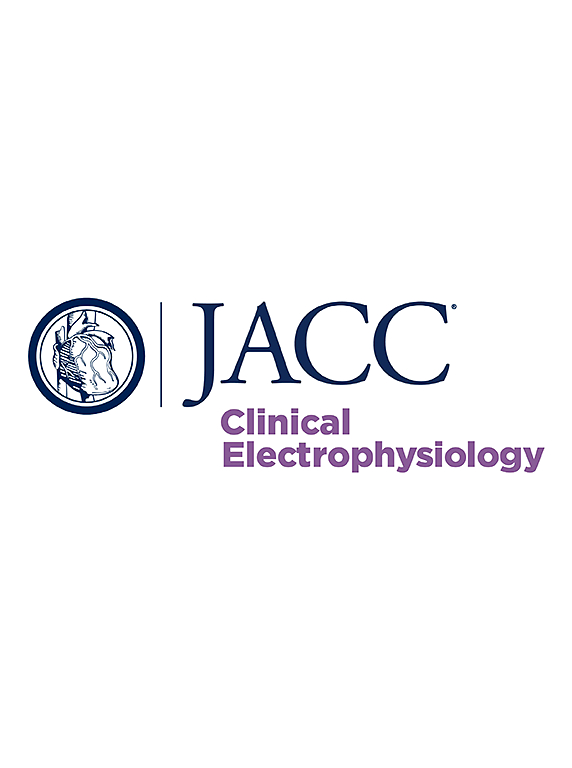Whole-Heart Histological and CMR Validation of Electroanatomic Mapping by Multielectrode Catheters in an Ovine Model
IF 8
1区 医学
Q1 CARDIAC & CARDIOVASCULAR SYSTEMS
引用次数: 0
Abstract
Background
Accurate electroanatomic mapping is critical for identifying scar and the long-term success of ventricular tachycardia ablation.
Objectives
This study sought to determine the accuracy of multielectrode mapping (MEM) catheters to identify scar on cardiac magnetic resonance (CMR) and histopathology.
Methods
In an ovine model of myocardial infarction, we examined the effect of electrode size, spacing, and mapping rhythm on scar identification compared to CMR and histopathology using 5 multielectrode mapping catheters. We co-registered electroanatomic mapping, CMR, and histopathology for comparison. Catheter-specific voltage thresholds were identified based on underlying amounts of normal myocardium on transmural histology biopsies.
Results
Ten animals were included: 6 with anteroseptal myocardial infarction and 4 control animals. A total of 419,597 points were manually reviewed across the catheters, with 315,487 points used in the analysis. There were minimal differences in bipolar and unipolar voltages, scar areas, and abnormal electrograms between catheters and between rhythms. Catheter-specific bipolar and unipolar voltage thresholds for normal myocardium were High-Density Grid >2.78 mV and >6.19 mV, DuoDecapolar >2.22 mV and >6.05 mV, PentaRay >1.66 mV and >5.35 mV, Decanav >1.36 mV and >4.75 mV, Orion >1.21 mV and >6.05 mV, respectively. Catheter-specific bipolar thresholds improved the accuracy for detecting endo-mid myocardial scar on CMR by 1.8%-15.6% and catheter-specific unipolar thresholds improved the accuracy in the mid-epicardial layers by 25.3%-81.1%.
Conclusions
Minimal differences were observed in scar detection and electrogram markers between commercially available multielectrode mapping catheters and differing wave fronts. Compared to traditional voltage criteria for bipolar and unipolar scar, catheter-specific thresholds markedly improved accuracy for delineating scar on CMR.
绵羊模型中多电极导管电解剖定位的全心脏组织学和CMR验证。
背景:准确的电解剖定位对于识别瘢痕和室性心动过速消融的长期成功至关重要。目的:本研究旨在确定多电极定位(MEM)导管在心脏磁共振(CMR)和组织病理学上识别疤痕的准确性。方法:在绵羊心肌梗死模型中,我们使用5个多电极作图导管,与CMR和组织病理学相比,研究了电极大小、间距和作图节奏对疤痕识别的影响。我们联合登记了电解剖作图、CMR和组织病理学进行比较。导管特异性电压阈值是根据经壁组织学活检的正常心肌的潜在量确定的。结果:共纳入10只动物:房间隔心肌梗死6只,对照组4只。人工检查了419,597个点,其中315,487个点用于分析。导管之间和节律之间的双极和单极电压、疤痕面积和异常心电图差异极小。正常心肌导管特异性双极和单极电压阈值分别为高密度栅极>2.78 mV和>6.19 mV,十二指肠极>2.22 mV和>6.05 mV, PentaRay >1.66 mV和>5.35 mV, Decanav >1.36 mV和>4.75 mV, Orion >1.21 mV和>6.05 mV。导管特异性双极阈值使CMR检测心外膜中层心肌瘢痕的准确性提高1.8%-15.6%,导管特异性单极阈值使心外膜中层的准确性提高25.3%-81.1%。结论:在市售的多电极测图导管和不同的波前之间,观察到疤痕检测和电图标记的微小差异。与双极和单极疤痕的传统电压标准相比,导管特异性阈值显着提高了CMR描述疤痕的准确性。
本文章由计算机程序翻译,如有差异,请以英文原文为准。
求助全文
约1分钟内获得全文
求助全文
来源期刊

JACC. Clinical electrophysiology
CARDIAC & CARDIOVASCULAR SYSTEMS-
CiteScore
10.30
自引率
5.70%
发文量
250
期刊介绍:
JACC: Clinical Electrophysiology is one of a family of specialist journals launched by the renowned Journal of the American College of Cardiology (JACC). It encompasses all aspects of the epidemiology, pathogenesis, diagnosis and treatment of cardiac arrhythmias. Submissions of original research and state-of-the-art reviews from cardiology, cardiovascular surgery, neurology, outcomes research, and related fields are encouraged. Experimental and preclinical work that directly relates to diagnostic or therapeutic interventions are also encouraged. In general, case reports will not be considered for publication.
 求助内容:
求助内容: 应助结果提醒方式:
应助结果提醒方式:


